10 reasons you need to take back your marketing
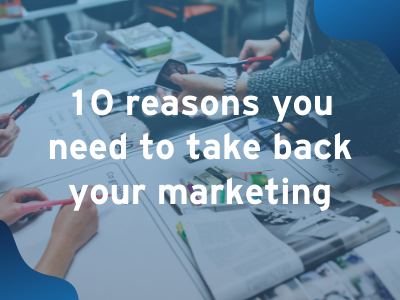
Misconceptions and bad marketing experiences are common. For many businesses marketing is an afterthought. Or they are using the same channels and methods they’ve used for years. Thinking, it worked before; why wouldn’t it work now? Others have been burned in the past by marketers who sold them bogus solutions.
Here are 10 reasons you need to take back your marketing!
3 common reasons people don’t trust marketers
Most of “marketing’s” bad reputation is because some marketers are unethical. Marketing is not lying or manipulation. Not being 100% honest about what the product or service is or what it does is lying. What are three common ways unethical marketers hurt their customers?
1. Inflating expectations
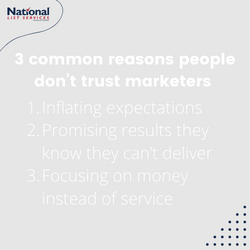
Over promising a product’s effectiveness or making sweeping claims is lying. It’s can also be manipulating to use language or wording that relies on implied meaning and the consumer’s own logic.
For example, selling a cookbook by saying “the food in this cookbook will help you lose weight” is lying. It could be justified by assuming that consumers reading that phrase will understand the implied logic that other changes in their diet or lifestyle will probably be needed to lose weight.
There are always other ways to say things. It’s possible, to be honest and still use hooky and engaging language. Relying on implied meaning is just lazy.
2. Promising results they know they can’t deliver
The key here is promising a result that they know they can’t deliver when they make the promise. There are many variables in marketing and there are circumstances that can’t be accounted for sometimes. However, promising a result that isn’t doable is wrong. It is totally understandable that people who have had this experience with marketers have difficulty trusting any marketer’s promises.
Although it may not feel like lying, not delivering on promises because of a lack of research or inexperience is still wrong. We are accountable for our actions. If we promise a result, we have an obligation to deliver it.
3. Focusing on money instead of service
This isn’t just a problem within the marketing industry. Many businesses ignore the fact that people (and therefore service) is what makes money. How has this attitude made it difficult for people to trust marketers? Not focusing on service shows a lack of concern and empathy for the customer. Customers (all of us) can feel when someone we are working with doesn’t actually care about wellbeing or success. Unfortunately, some marketers are only concerned with their own successes and not their customer’s success. The irony is that marketing in general is about building a client’s business and setting them up for success.
4 common misconceptions people have about marketing
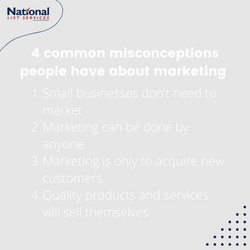
Another reason many people and businesses need to take back their marketing is that misconceptions about what marketing is abound. Many people don’t understand what marketing actually is or why their business needs marketing in general. Here are four common misconceptions.
1. Small businesses don’t need to market
Many people feel like marketing is a waste of time and/or money for small businesses. The reasoning is that many small business owners are extremely busy, and marketing isn’t a necessity. Is that true? Not at all.
For one thing, “marketing” encompasses a lot more than people think it does. Any time or way a customer interacts with your company is marketing. It’s especially important that small businesses think about their marketing. (Their brand strategy specifically.)
Small businesses do need to market differently than larger businesses. To make more effective use of time and budget, smaller businesses need to have a clear and well-thought-out marketing strategy. It’s important to think about what channels are used and how campaigns are executed. campaigns need to be rolled out slowly and methodically. It’s also super important that small businesses collect and use data and analytics from their marketing.
2. Marketing can be done by anyone
For some reason, there is a stereotype that marketing is easy. That misconception is probably why many people try to handle marketing their business themselves. “Try” is the keyword there. And yes, Canva is free. Anyone can throw something together for their business. There’s also always a chance that a haphazardly thrown-together ad or post might work. “Pray and Spray” is a thing for a reason. The question is whether that method of marketing is the most effective or most efficient use of a marketing budget.
Marketing takes a lot of time and effort. It requires skill and dedication. Having a clear strategy and understanding the reasons why something will work takes a level of commitment and research that many don’t have the time to do. Even if someone does have time, it might not be the most efficient use of their time.
In the long run, having a professional do your marketing will give you a stronger foundation for success.
3. Marketing is only to acquire new customers
Simply, if you stop marketing as soon as you get a customer, they aren’t going to be a customer for very long. Marketing is also necessary to build relationships with customers and build loyalty. Returning customers are essential for success and growth.
4. Quality products and services will sell themselves
Wouldn’t that be nice? Unfortunately, having a great product isn’t enough. A product is worthless if no one knows about it. Marketing is necessary to find and retain customers.
3 common mistakes people make with their marketing
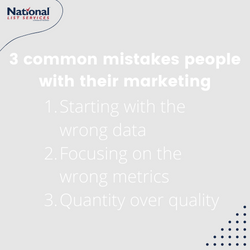
People also need to take back their marketing because many people lack the right information to build successful campaigns. Here are three super common marketing mistakes.
1. Starting with the wrong data
Starting with the wrong data might be a little generous. Many people don’t use data in their marketing at all. Marketing data covers a lot of different things but mostly it is about people. Using accurate data helps you know who to market to. Data informs what type of person who should be marketing to. Marketing data also encompasses specific contact information.
Using the wrong data (or no data) is like putting regular gasoline in a diesel truck, you may think you are getting somewhere, but it’s just going to blow up in your face. 💥
2. Focusing on the wrong metrics
It’s easy to get distracted by vanity metrics. Having lots of followers or views on a video is great but are they the numbers that you need to be looking at? Without clearly defined goals or targets you don’t know what matters to you.
3. Quantity over quality
Quantity of marketing efforts will probably show you quick results, but the poor quality will hurt you in the long run. The sheer amount of products, companies, and information available now is staggering. Having your product in your consumer’s face isn’t enough anymore, your brand ideals and personality also need to match with the personality of your consumers.
For example, 56% of Gen Z consumers say that having shared passions and perspectives is a major factor when it comes to their engagement with a brand. Additionally, 72% of consumers want the brands they care about to be positive contributors to society. We’ve seen in recent years that many brands (especially smaller companies) connect their core brand to a charity or cause they care about. Younger consumers are 69% more likely to buy from a brand that contributes to a cause.
If you are focusing and the amount of content you are putting out and not what the content is saying, then you are giving up control of how you are seen. Instead, you are allowing your marketing to imply who you are. Chances are that quantity of marketing over quality is implying that your company does not care about quality. What does that say about your product or service?
This is not to say that quantity of marketing is bad! Quite the contrary. However, you cannot allow your quality to suffer from quantity.
10 reasons is a lot of reasons to take back your marketing. Are you up for the challenge?
3 Things to focus your Content on in 2022
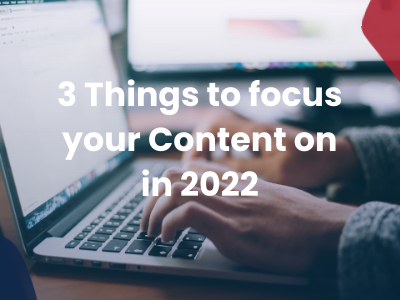
The end of the year always provides such a good time to reflect on trends and the direction we’re going! After a year with so many transitions across industries, privacy laws, and marketing channels, our focuses for next year have also shifted! One area to focus on in 2022 is content marketing.
If these last few years have taught us anything, it’s that content-based marketing really is one of the most important pieces of marketing. Your approach to content informs many aspects of business, not just marketing. Content covers all the ways you communicate. It’s tied to branding and mission and purpose and your focus. The type of content you produce helps you make decisions about marketing channels and our audience.
Content Trends 2022
With the rise of content marketing, ecommerce, and digital advertising, everyone acknowledges that social media, blogs, email marketing, etc. are all effective ways to sell people. The problem is that the very nature of content marketing erases the lines between education, entertainment, and sales. We have become so inundated with ads that our brains have been conditioned to go on the defensive when we feel like we are being sold.
An often-quoted marketing research study from 2007 found that the average American saw 5,000 advertisements a day. 5,000 ads a day pre-digital billboards, pre-Farmville, pre-Instagram, and pre-iPhone. Current estimates put the average number ads seen every day closer to 10,000. The 2007 study warned that number of ads cluttering our life would push for innovation in advertising that would in turn, create more clutter.
What can we do to cut through the clutter in 2022? Content marketing is an effective way because if done well, isn’t actually an ad and will actually reach the consumer.
Here’s three trends/focuses to incorporate into your 2022 content marketing.
Storytelling
This ties into the old writing rule: show don’t tell. Telling a customer how great you are won’t make them believe you. Showing them will prove it to them. But weaving a story around your product, brand, and successes will build an emotional connection between you and your customers.
Education
This goes hand in hand with storytelling and the inundation of advertising we all deal with. We have an excessive number of options to choose from. As well as our personal connection with brands, we use things like Social Proof to help us decide what products to buy. Brands can use this to their advantage by educating customers about their product instead of selling their product. The focus on pure information takes the pressure off the consumer to purchase. In turn, an educated customer is more likely to purchase.
Personalization
Even with increased privacy and data laws, there is more access to information about customers than ever. We often talk about personalized advertising in connection with retargeting and audience segmentation. It’s easy with personalization to focus on how specific and personalized you can get your advertising. ‘If someone clicks this and this and lives in these areas then we know all of this about them and can serve an ad for this specific product.’ That type of thinking is very valuable and helps you communicate effectively with your customers.
But personalized advertising doesn’t need to be that minute; it can be as simple as thinking about what channel you are using. Are you making blog content? What type of person reads blogs? You could build out a detailed buyer persona based on analytics and write with them in mind. That is very personalized! Or you could use common sense to tell you that most people who read blogs are probably interested in educating themselves, which also gives you a lot of information to personalize. The personalization can just be the focus of the channel. ‘These consumers are here to be educated, so we are going to educate them.’
Spotlighted Marketing Channel: CTV
Many marketers are using CTV (connected TV) or OTT (over-the-top) channels to target consumers using streaming services and connected TV devices such as Hulu and Roku. Advertisers are embracing these platforms as more and more ad space becomes available. Spending for CTV advertising grew from $6.94 billion in 2019 to $8.88 billion in 2020, a 28% increase.
Advertiser spent an estimated $8.88 billion on CTV in 2020
Read more about the future of CTV here!
What things are you excited to focus on in 2022?
It’s Holiday Campaign Time… Already
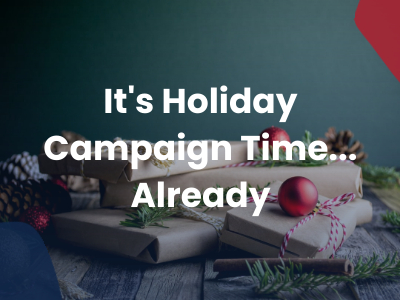
55% of consumers say that they will start their holiday shopping before Halloween this year. This means, the holiday season is here early! Consumers are worried about increased shipping times and product outages, pushing them to get their shopping done early. Americans are also expected to spend 7%-9% more this holiday season! What do you need to get your Holiday campaign set up on time?
Supply Chain and Shipping Issues
Pandemic-related shipping delays have gotten a lot better this year, but many companies are expecting large delays, due to volume, this holiday season. Also, many shipping companies’ deadline for Christmas deliveries is earlier this year. For example, FedEx’s Economy deadline is December 9th, UPS is December 16th, and USPS is the 15th. USPS also updated Holiday pricing this week on October 3rd.
Just about every part of the supply chain has been disrupted. There’s a shortages of factory workers, shortages of cargo ships and containers, large scale storms, a lack of truck drivers and warehouse employees, and retail workers. Big companies like Nike, H&M, and Ikea have already been affected.
What does this mean for you?
The best time to get started on your holiday campaign is RIGHT NOW. Especially if you are a small business; take advantage of all those big companies’ supply chain issues!
Good campaigns take time to set up and the sooner you can get your message out, the better. In the past the rule of thumb has been to have your campaign live by November 19th; however, a lot of brands have already started easing into their holiday campaigns. (Looking at you, Pottery Barn.)
What do you need to set up your holiday campaign?
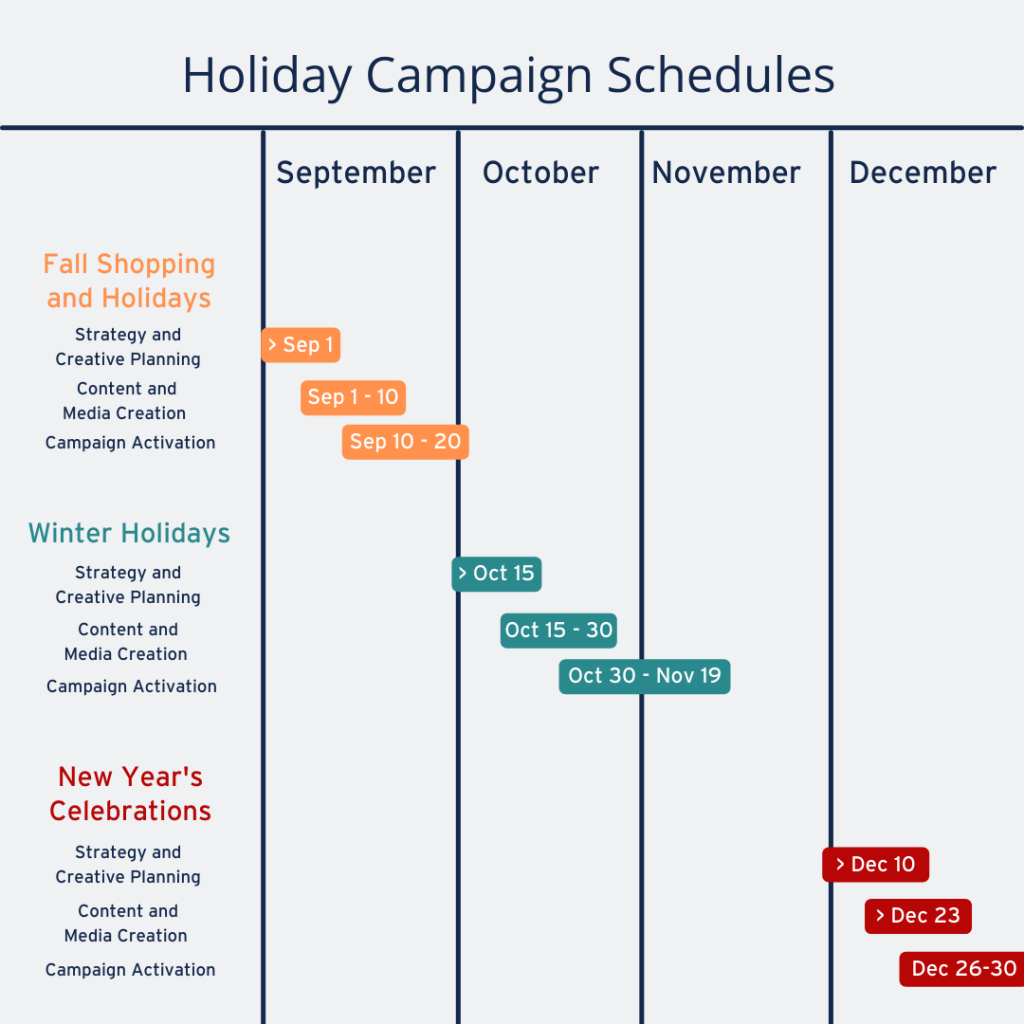
Step 1. Have a plan! That’s why it’s a campaign and not just content! A strategy is key! How do you know what should be holiday 2021 strategy? Start by asking the “why.” Why are you doing a holiday campaign in the first place? Do you have an awesome product that a lot of people would love? The next step is the campaign objectives. What do you want to specifically do you want to accomplish with this campaign? Are you trying to build brand awareness, drive traffic, or sell a specific product? Once you know what you want to accomplish, the next step is to figure out what channels and methods would be the most effective way to reach your audience.
All of these things are your strategy: the why, the what, and the how.
The next step to planning a campaign is content and message. You know what your goal is, now you make the creative that goes with it. Whether that be social content, print and mail, or digital ads, or hopefully, some combination of all the channels!
After putting your campaign out into the world, the next step is to learn. This is the data gathering and retargeting phase. A one step campaign isn’t going to be as effective as a campaign that customers on a journey.
Marketing Channel highlight: TikTok
TikTok is going to be a powerful channel this holiday season. 47% of surveyed TikTok users said that TikTok is likely to inspire a gift this year. 39% said that they discovered a product or brand on TikTok, and 77% said that they have bought things because of TikTok. TikTok is also offering incentives for advertisers to use their platform.
Do you have your holiday campaign ready to go?
What is the foundation of all effective marketing?
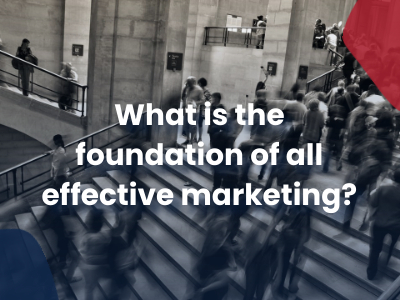
Most people’s favorite part of building a marketing campaign are the visuals. While how your marketing looks is important, who you are sending it to, and how you are sending it should be the first step with any marketing. Those two things inform everyone’s favorite part of marketing: results.
It’s like a luxury car…looks beautiful and sure makes an impression, but if there’s no gas in the tank, it won’t go anywhere. Going (hopefully fast) is the goal!
So, how do you know what the best fuel is for your marketing campaign?
The right fuel is determined by who your audience is, what your campaign objectives are, and the best ways to reach your audience.
Which comes back to the two most common questions we get asked:
- What data do I need for marketing?
- How do I reach my customers?
What data do I need for marketing?
Really the first question is: what data is available? Viant had a great illustration about the different types of marketing data.

Data Types (Explained with Cows)
First-Party Data
You own a cow. You know the cow’s name, what it eats and where it sleeps. These are your customers; you have their contact information in your CRM. They know you have their information.
Second-Party Data

You rent some cows from a friend for a fee but you don’t necessarily know the cow’s name, what it eats, or where it sleeps. You have to pay your friend each time you need some milk. Second-party data is first-party data sold to another company for a specific use. For example, say you own a company and you looking to expand into a new market. You can buy a list of first-party customer data from a company in the new market you are tapping into and market to them for an agreed-upon number of times. However, with the increased privacy and data laws using second-party data can sometimes be problematic.
Third-Party Data
There’s a village full of cows that were bought, rented, or found. The cows with similar traits are herded together and sold to you. You don’t know where the cows came from or sometimes if this is even a real cow. Traditional list data and many digital audiences call into this category. Which is one reason it’s so important to get data from a good source! You need to be able to trust that you aren’t buying fake cows or ones that don’t match the traits you need. Another thing to remember about 3rd party data is that it is the most impacted by the cookie and privacy laws! Relying too much on traditional 3rd party data can set you up for failure in the future.

Looking into the future with post cookie advertising, traditional 2nd and 3rd party data channels are going to change. The ways to gather consumer data have already changed in a lot of ways. For example, Connected TV doesn’t support cookies and instead relies on IP targeting. This is data you can use for marketing but doesn’t have the same types of information you would get with traditional list data. You are going to get demographic data and location data but probably not names or a specific address. Using IP targeting is a great way to maintain your same flow of data-driven campaigns while still working within updated privacy laws.
This is often called people-based data. When you use people-based data you know you are reaching real people in real households.
What data do you actually need?
The data you need is based on two things: What do you know about the people you are trying to reach? What is your goal with this campaign? What you know about who you are trying to reach impacts your demographics and helps informs decisions about methods and channels. Your campaign goal also helps you figure out what channels to use as well as campaign scale and message.
Questions you can ask to help learn about your customers:
- What are their basic demographics?
What gender to they identify as? How old are they? Where do they live? What is their relationship status? Are they educated? - What do they do for work?
What’s their job title and description? But more than that, are they a decision maker? What do they influence at work? - What are their interests?
Do they have hobbies or interests? What do they do in their free time? Are they part of a community? - What do they want and why can’t they have?
This a big thing for figuring out what you can do to help them! What are their goals and dreams? What are their pain points? Like, what keeps them up at night? - Why wouldn’t they buy from you?
What’s stopping them from buying from you? What objections may they have? - What ways would they prefer to interact with you?
Do they use social media? Do like a particular social media? Is a phone call the best way to reach them?
Learning about your customers and the best way to communicate with them is the foundation of effective marketing! Effective marketing = results!
What Can Your Team Do Stay Productive?

When working as part of a team, how we work alone as well as how we work together contributes to productivity and efficiency. When employees are stressed or exhausted, engagement and productivity dip and the whole company can feel the effects. It can be hard to stay productive.
Managing stress has been a challenge for a lot of people this year. In Asana’s Anatomy of Work 2021 study, 71% of workers said that they felt burnt out at least once in the last year. Also, 42% rated their stress levels as high or very high. 😳
So, what can you as an individual and you as a team do to maintain your efficiency and productivity?
What Can You Do as A Team to Stay Productive?
Unfortunately, work related stress often has to do with environment. When one person is feeling burnt out on your team, it can bring the whole team down. What can you do to create a less stress inducing work environment?
Talk It Out
Ewww, right? However, it’s impossible to know what is wrong or how you can help a situation if you don’t know at the problem is. Take in interest in people you work with. Is there anything going on in their life that might be adding stress? Is a process or workflow just not working for and its making things difficult?
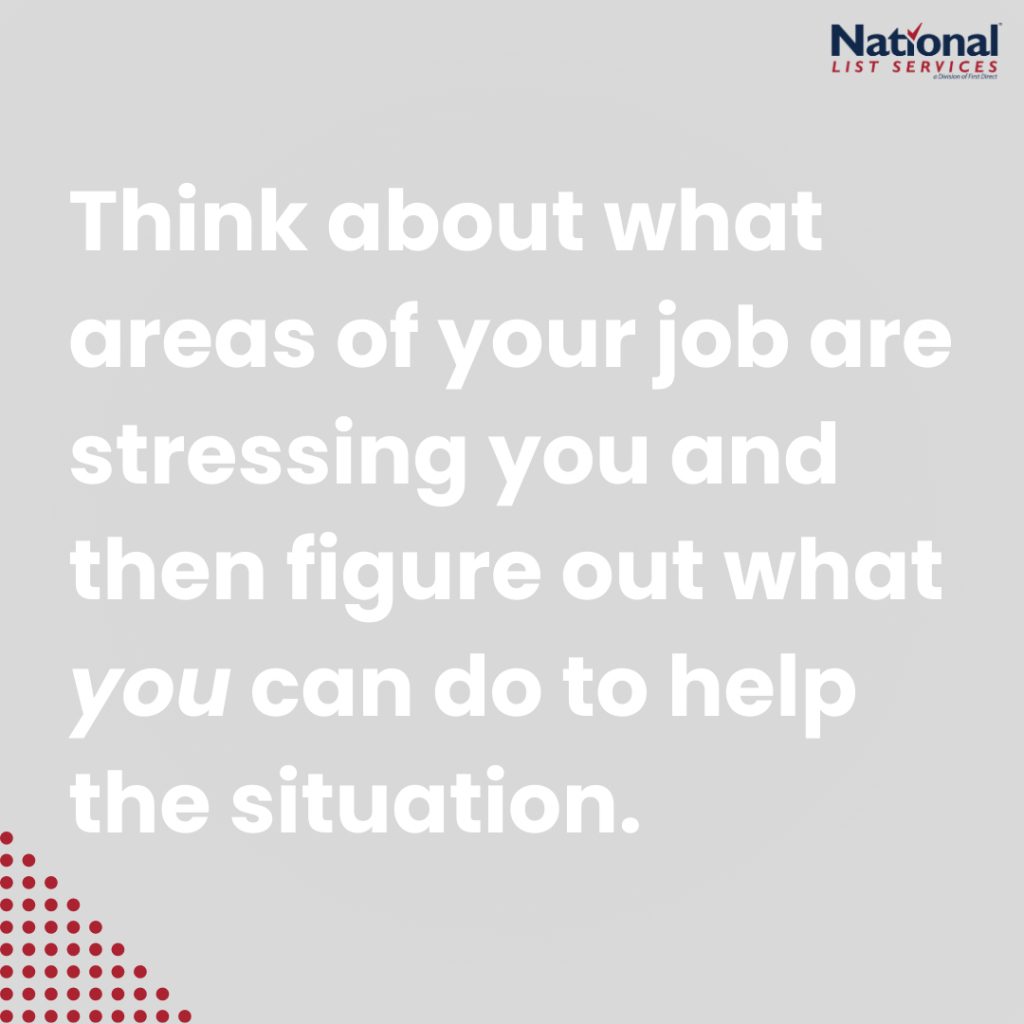
Once you understand how your team is feeling, don’t disregard it! See what you can do to make things run smoother.
Take Control Over Your Situation
We are all responsible for ourselves. If you are lucky enough to have anatomy in your job, use it! Think about what areas of your job are stressing you and then figure out what you can do to help the situation. For example, do you struggle with being productive in the afternoons because you hit a massive exhaustion wall? Could you be hitting that dip because you constantly don’t get enough sleep? Or does coffee make you crash? Those are things that you have control over and can change.
And after this year, more and more companies are realizing that giving their employees flexibility over schedule and in some cases, whether they want to work from home, actually increases productivity!
Minimize Distractions
The Asana study mentioned early found that “work about work” took up 60% of most employee’s days. That “work about work” is things like, meetings about processes, communicating about specific tasks, switching between tools, waiting for apps to load, searching for information, following up with team members about a project’s status, and managing shifted task priorities. A lot of those things are things that you don’t have control over. However, dealing with tasks like that can quickly give you the feeling of being on a work sized hamster wheel. That’s partly because “work about work” doesn’t feel like you are accomplishing anything.
What can help you feel in control? Figure out the right processes and find the right tools. If you can work with your team to put an effective process in place for dealing with collaborative projects. Part of that involves finding the right tools. There are so many workflow and team management tools available now that it shouldn’t be difficult to find one that works for you and your budget. (We are big fans of Teams/Planner and good old fashioned white boards.)
Time Management
Time management single handedly has the biggest impact on work stressor and burn out. Good time management can drastically increase your productivity and give you more time to focus on other aspects of your life. A healthy work-life balance will help aspects of your life, including reducing stress!
Connect Your Targets to Big Goals
Time management is about getting the work done, it about getting the right things done at the time. A big part of understanding and prioritizing what’s most important is know what are your goals. And if you work for a company, what its goals are. A recent study found that only 26% of employees understand how their work relates to the overall company goals. How can you know what daily targets to set if you don’t understand where you are trying to go?
Only 26% of employees understand how their work relates to the overall company goals
This goes back to talk it out. If you have questions, ask! And if you are in a management position, work with your employees so everyone understands what they are doing to help the company reach its goals!
Prioritize and Organize
Its critical to understand what tasks are most important. Inevitably things change throughout the day; deadlines move and priorities shift. If you understand what’s most important in the grand scheme, however, it can make adapting to those changes easier. In the Asana study, they found that 29% of employees cited confusion on task priorities as a contributing factor to their burnout.

There are many different methods to prioritizing and organizing your daily tasks. The “Eat The Frog” method (named after the famous Mark Twain quote) encourages you to take care of the big or complex tasks first thing in the morning. This way you are productive right out the gate and don’t have a big task hanging over your head all day. Once you’ve eaten the frog you can move to other things.
Another popular method is David Allen’s “Getting Things Done” method. The first step in this method is write everything you need to get done down. Once you have an overview it’s easy to see what tasks are important. Writing it all down and putting it one place frees up brain power and lets you focus on actually getting the stuff done.
Plan Ahead
Writing down your targets for the next day before you finish for the night or as you think of it, helps you feel on top of the day as soon as it starts. Spending a few minutes to plan out tomorrow’s tasks is way easier than spending the first part of your day scrambling to remember what was a priority to get done that day. This will also help your work life balance because you don’t have to keep thinking about all you have tomorrow.
Say “No” or Delegate
This is a struggle, we know. But one advantage of having clear, prioritized tasks, is that you can see when a task is not a priority or not one you have time for. It’s easier to explain why you are saying no if everyone knows what your current priorities are. Sharing your clearly defined priorities with your team gives everyone more clearly. This is something that we have found to be successful. In our morning meeting we often go through what everyone’s priority tasks for the day are. By doing this, we know what each of us needs to be focusing on and how much a priority it is to reach our company goals. It also makes it easier to see where we could help.

Knowing what your team’s priorities are, can also make it easier to delegate tasks. Just because something is a priority task for you doesn’t mean it’s not important! Help it get to the right person and that benefits everyone.
Audit Your Tasks
Is there anything on your plate right now that doesn’t align with your goals? Ask yourself, is this task not a priority for today anymore? Or is it not a priority at all? If the task is still important but keeps getting moved to the bottom of your priorities, ask yourself if you are the right person to be handling it?
Another aspect of auditing task is looking at how you view the task. Are you procrastinating the task because you don’t really want to do it? It’s easy to add time to situations if want to avoid the task. However, tasks don’t usually take care of themselves. (wouldn’t that be nice?) procrastinating the task will just make it worse. And often, when we finally do something, we’ve been procrastinating, we find it wasn’t that difficult in the first place!
What have you found successful in dealing with work stress? Any time management tricks you swear by?
How do these marketing channels stack up?
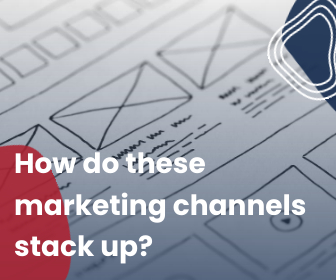
There are A LOT of different marketing channels out there. What are the pros and cons of some of the common ones?
Social Media
Pro
There are over 3.8 billion people on social media around the world. Social media is a fantastic way to connect with customers, build brand loyalty, and generate sales.
People don’t just want to buy from companies because they have good products and services. They want to know what your brand stands for in addition to what it sells. Social media can help potential customers get to you. Social media feel like a 1-on-1 conversation between the brand and consumer, which helps build loyalty.
Con
A lot of the value from social doesn’t show up immediately. It’s rarely simple to track social media’s ROI. Often the goal of social media is not just to generate sales but instead to build connections. Without measurable results, using social media can be discouraging.

Pro
Often it a brand’s only way to communicate with customers and can feel very one on one. A lot of millennial and gen z’ers expect to communicate with brands through email. Also, pretty much everyone has email so you know you will be able to communicate with people through email.
Con
We all get so. many. emails. Most office workers receive 127 every day. It can be hard to stand out from the crowd. People don’t have time to read emails that don’t actually provide them value.
Email marketing also has a lot of laws and rules connected to it that can hurt you if your aren’t careful!
Content/SEO

Pro
Customers often rely on a business’s website for information. Especially for local businesses, it can be the only way to know a shop hours or address. Putting the information on a website instead of a social media or directly in a browser legitimizes the information.
Good SEO gives your website credibility. It makes it easier for people to find your website when they search for it. And it helps create a smoother user experience.
Con
Bad SEO can hurt you. Most searchers never go past the first or second page of Google, though, which is why those top spots in the search results are so coveted. Having the proper SEO can prevent your website form getting organic traffic.
53% of all trackable website traffic comes from organic search. SEO is the main thing influencing how easy it is to find you online organically. Which is probably why it’s estimated that agencies and brands spent over $79.27 Billion on SEO services last year.
Google Ads

Pro
Where are people? On their phones. So, google ads is an extremely effective way to find people where they are. Google ads is great for brand awarness as well as retargeting. It is great if you want measurable results and analytics.
Con
Billboards, signs, posters, newspapers, and magazines all exist with in different physical spaces. With digital advertising however, we are all competing for the same ad space. That ad space is worth more now has less guarantees attached to it.
Trying to figure Google ads can feel like rocket science. There’s a large learning curve and it can a while to feel confident in the set up.
Print and Mail

Pro
Direct mail average open rate is somewhere between 68 and 90%, which is double, triple, or quadruple the average open rates of other marketing channels. Do people who open direct mail actually purchase? Yes! On average people who receive direct mail purchase 28% more items and spend 28% more money!
Why is direct mail so effective? It comes down to fact that we (humans) like getting mail. 41% of Americans of all ages look forward to getting their mail every day. We still want very real things in our hands, which is something totally lost in email inboxes or on social media. That tactile connection translates into 💰.
Con
Since Direct mail requires use of the postal system it has fixed costs. The graphic design of the mail piece may also have an additional cost. Using direct always requires a bit of math and if done wrong can hurt your ROI.
It’s not always posable to see direct, measurable results, from Direct mail campaigns. And if you can measure results, it may take a while to get the full picture.
Another thing that can be a disadvantage to direct mail is that you need a really good foundation of address data. The problem us that a lot of data providers don’t make sure that their data is accurate and that hurts the effectiveness of your campaign.
Connected TV

Pro
TV is a time-tested advertising channel. Although it’s a lot less common than it used to be, it can still be very effective. Many marketers are using CTV (connected TV) or OTT (over-the-top) channels to target consumers using streaming services and connected TV devices such as Hulu and Roku. Advertises are embracing these platforms as more and more ad space becomes available. Spending for CTV advertising is expected to grow from $6.94 billion in 2019 to $8.88 billion in 2020, a 28% increase.
Con
With customer attention spread so thin and cable tv subscriptions consistently falling, (over 16 million in the last five years) there’s a lot less advertising space available. Content consumption is at an all-time high and therefore, competition for viewer’s attention is as well. 84% of marketers say that it is getting harder to grab a consumer’s attention with television advertising alone.
Audiences today expect personalized and relevant targeted ads. Linear TV (cable and network television) often fall far behind in targeting capabilities. Therefore, it can be a challenge for advertisers to figure out how to integrate linear TV into their campaigns.
How to get past creative blocks
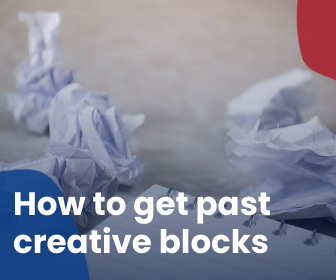
Whether or not you think of yourself as creative person, all jobs required creative thinking. And especially as marketers we produce a lot of content, for ourselves and our clients. However, it can be difficult to continue to produce high-quality content when we don’t feel creative or inspired.
Fortunately, there are things we can do to get over (or prevent) creative blocks.
Take a break
Remember your brain is a muscle and needs rest time. During our break time out brains continue to process ideas. Therefore, breaks can boost our creativity and give us new ideas.
One of the most effective ways to get over a creative break is to take a break outside. The University of Michigan found that walking outside (preferably in nature) improved attention spans and memory performance over 20%! They found that walking outside, no matter the temperature, had the same mental effects as meditation.
Don’t force it
Our brains don’t have an endless well of content ideas. And we can’t force ourselves to be creative. It’s okay to just walk away. One way to keep to refilling the well is to just do something else. Change your scenery, have conversations, read books or articles, watch a movie or show. Diversity of other creative inputs will refill your own creativity.
Inspiration can be found anywhere but it’s easier to find it when you are being active. Take opportunities to use other parts of your brain and senses! It could even be a monotonous task that you normally don’t enjoy, but the switch up will help get the juices flowing.
Focus on the process, not on the results.
Making content isn’t just about the result. There are many steps along the way. Finding joy in all the steps can make it easier to stay motivated.
Befriend your inner critic
There will be bumps in the road. It impossible to make perfect content, the first time, every time. Taking risks will help sharpen your skills and build your confidence. Don’t afraid to befriend your inner critic. Not letting yourself fail or telling yourself that you aren’t able to succeed both result in failure. It ok! Your inner critic and any failure is how you learn and grow. The fast you acknowledge your critic and failure, the faster you’ll be able to get past the block and make something you are proud of. It’s all part of the process!
“It’s through mistakes that you actually can grow. You have to get bad in order to get good.”
Paula Scher
Listen to yourself
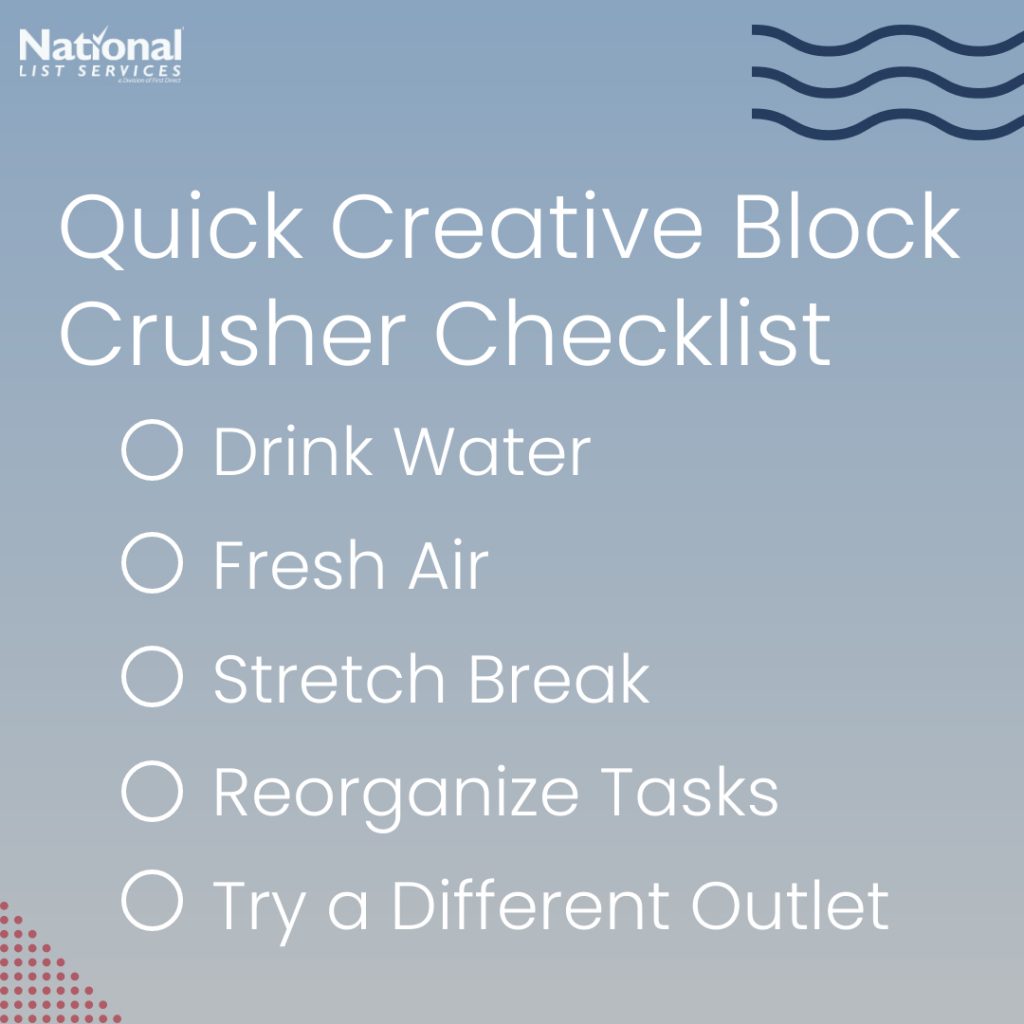
Although it may feel like it, creative blocks don’t just appear out of nowhere. Often, a lack of creativity comes from not taking care of your physical or mental health. It’s difficult to feel motivated and inspired if you’re exhausted.
So, check in on yourself. Are you getting enough sleep? When was the last time you drank water? It’s easy to want to power through and get things done but that mentality will come back to bite you later.
Audit your task list
Sometimes a task can seem so big and overwhelming that it’s hard to know where to start and we just don’t. It can paralyze your creativity. The easiest solution is to organize and prioritize your tasks. Cut the task into smaller chunks if you need to.
Ways to divide tasks
There are many different methods to prioritizing and organizing your daily tasks. The “Eat the Frog” method (named after the famous Mark Twain quote) encourages you to take care of the big or complex tasks first thing in the morning. This way you are productive right out the gate and don’t have a big task hanging over your head all day. Once you’ve eaten the frog you can move to other things.
Another popular method is David Allen’s “Getting Things Done” method. The first step in this method is write everything you need to get done down. Once you have an overview it’s easy to see what tasks are important. Writing it all down and putting it one place frees up brain power and lets you focus on getting the stuff done.
“Great things are not done by impulse, but by a series of small things brought together.”
Van Gogh
Plan ahead
Writing down your targets for the next day before you finish for the night or as you think of it, helps you feel on top of the day as soon as it starts. Spending a few minutes to plan out tomorrow’s tasks is way easier than spending the first part of your day scrambling to remember what was a priority to get done that day. This will also help your work life balance because you don’t have to keep thinking about all you have tomorrow.
Another aspect of auditing task is looking at how you view the task. Are you procrastinating the task because you don’t really want to do it? It’s easy to add time to situations if want to avoid the task. However, tasks don’t usually take care of themselves. (wouldn’t that be nice?) procrastinating the task will just make it worse. And often, when we finally do something, we’ve been procrastinating, we find it wasn’t that difficult in the first place!
What is your go-to way to get past creative blocks?
7 Ways To Make More Engaging Content
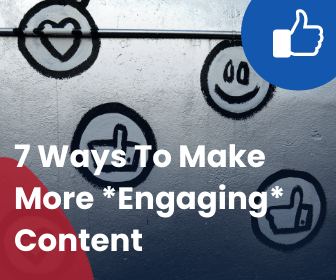
Content creation is an integral part of marketing or running a business in general now. However, a lot of companies struggle with creating content that generates engagement. Part of the value of content creation is that engagement and the conversation between brand and consumer. What can you do to create engaging content for your brand?
Here’s 7 things we have found to be essential in making quality content!
Know Your Audience
The content you create for one audience can be very different from another. Understanding the WHO is helpful first step.
It can also be helpful if you think of your audience as a single composite person. Instead of trying to talk to all of them, you are instead making content for one person. A lot of companies do this by making a buyer persona. That way you can think, “Would my buyer persona like this?” vs. “Would all my followers enjoy this content?”
Make a Plan
There is nothing more overwhelming than trying to maintain consistent content posting across multiple channels without a plan. It can feel like juggling snakes. 🐍 Making a plan can be as simple as figuring out what types of content you want to post and when it would be best to time to post it. The more specific your plan is the more you time you take out of the equation.
Part of making a plan is planning out your message and/or your angle. Now that you know who your audience is, think about what type of content would work best for them. Knowing what you want to talk about can make it easier to figure out what types of content would be best. Would your audience benefit from long form blog articles or would a TikTok series be more helpful? Both of those types of content take a lot of effort, so planning it out ahead of time is valuable!
Find Shared Passions
The sheer amount of product, companies, and information available is staggering. It is not enough anymore to have a good product available anymore, your brand ideals and personality need to match with the personality of your consumers. 56% of Gen Z consumers say that having shared passions and perspectives is a major factor when it comes to their engagement with a brand. However, most consumers are fantastic at sniffing out inauthenticity. Your brand personality and ideals need to actually be what you say they are. Actions speak louder than words!
What are the advantages of having a well-defined brand personality and ideals? Giving your company a personality makes things like content creation a lot easier. Knowing who you are also can help you make decisions about the direction you want to go in the future.
And 49% of young consumers say they will evangelize a brand they feel represents their values, likes, and personality.
Don’t be afraid of incorporating causes you care about into your brands personality! 72% of consumers want the brands they care about to be positive contributors to society. We’ve seen in recent years that many brands (especially smaller companies) connect their core brand to a charity or cause they care about. Younger consumers are 69% more likely to buy from a brand that contributes to a cause.
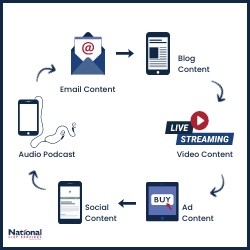
Keep It Simple
Don’t make it harder than it needs to be. No matter who your audience is, needlessly complicated language or content structure isn’t appreciated. Simple and honest is always good. Remember, why you are making the content. Is it to promote you or your brand? Then tone of the content should match your voice. People can see right through any inauthenticity if you are trying to make something that isn’t you.
It’s easier to connect with a brand online if you feel like you are talking to a real person. Does the content you are making sound personal?
Remember the Big Picture
Why do you want to make this content? Keep the big picture of your content in mind as well as each individual piece. Are you trying to promote a specific product or service? Don’t be afraid to include a call to action in your content! A call to action is how to accomplish the goal of your content. It’s the follow through.
A good call to action is simple and concise. It uses strong verbiage. Give your audience a good reason to take the desired action. Don’t be afraid to get creative!
Take a Step Back
When it comes to content, it’s often valuable to take a step back and from your project and let it rest for a bit. The longer you work on a piece of content the easier it is to be become blind to mistakes, errors, and typos. You may be surprised by the power of fresh eyes!
An old copy writer trick is to proofread backwards. Instead of starting at the beginning of your content: start at the end. Because your brain is following a different path through the information, it sees things in a different way. Starting at the end allows you to look at it sentence by sentence instead of word by word or thought by thought. Knowing your content is edited well will help you feel more confident in posting it.
Another aspect of taking a step back from your content is revisiting old content. Repurposing or adapting finished content is an excellent way to stay inspired and make more content. There are always new things that can be added. Adding information keeps your messages up to date. Up-to-date content is more accurate and provides for value to your followers. Another reason to recycle content is that it gives more people an opportunity to see it. And even if someone has been following you for a long time there’s a good chance that they didn’t see the content the first time around.

Keep Consuming Content
This is my favorite part. 😜 One of the best ways to keep your own content sharp is to consume other content. It can inspire you, help you stay up to date with current trends, and keep your skill sharp. Most ideas don’t start in our heads, the spark is external. All of the creative juices it takes to create content can easily be burnt out if you don’t feed it with creative thing that you care about. Change your scenery, have conversations, read books or articles, watch a movie or show. Diversity of other creative inputs will refill your own creativity!
What type of Content have you found to be the most engaging with your audience?
Are these Channels “DEAD?”
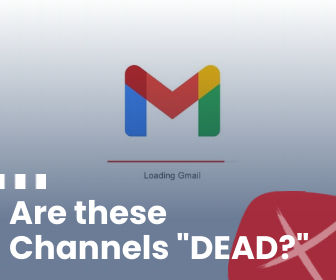
It seems like soooooo many articles/emails/ebooks/Facebook videos are titled something along the lines of: “blank” is dead. Or “Why the new ios update is going to kill email marketing.” Or “3 stats that prove print and mail is dead.” But it is? For the most part those titles are just clickbait, and the content just proves how it is very much not dead.
So, let’s take the three most common “dead” or “dying” marketing channels and see how effective they really are.
Email Marketing
I probably get an email once a week proclaiming the end of email marketing. How can email marketing be “dead?” Statista estimates that close to 320 BILLON emails will be sent every day in 2021. On average, office workers receive 127 every day. And a Forbes article from last year suggested that “every person needs at least four email accounts” for security reasons. However, quantity of emails is one reason some say that email marketing is losing its effectiveness as a marketing channel. Is that true?
Email is often one of the main touch points a brand has with a consumer and many younger consumers prefer to communicate with brands with email. Even email that’s clearly from a mailing list still feels like a direct conversation. Which contributes to email’s engagement rates. Across industry’s email average click-through-rate is 3.71 and the average open rate is 22.9. Although that may not seem like a lot, Facebook, Instagram, and twitters combined average engagement is only 0.58.
Part of the reason email gets better engagement rates is because with email, the message is directly reaching who it’s intended for.
Print and Mail
The death of print and mail has been predicted since the beginning of email. Probably even before then. One of the very first articles in our Weekly Vibe newsletter was called “Print’s Not Dead, Right?” It wasn’t in March 2020, and it defiantly isn’t now.
Direct mail average open rate is somewhere between 68 and 90%, which is double, triple, or quadruple the average open rates of other marketing channels. Do people who open direct mail actually purchase? Yes! On average people who receive direct mail purchase 28% more items and spend 28% more money!
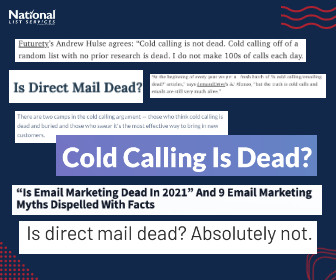
Why is direct mail so effective? It comes down to fact that we (humans) like getting mail. 41% of Americans of all ages look forward to getting their mail every day. We still want very real things in our hands, which is something totally lost in email inboxes or on social media. That tactile connection translates into 💰.
Cold Calling
Cold calling is another one of those things that’s been “on its way out” for years! Why is sticking around? At this point, an actual person to person conversation is a novelty and stands out against digital interactions. And sales, more than anything, based on connections and communications. It’s a lot easier to ignore an email than a ringing phone. It can also be harder to say no to a real person who you can actually hear.
If you add cold calling as part of your omnichannel marketing, work on your pitch, and be prepared to fail, you may be surprised at how effective it is!
What is your favorite marketing channel or tactic that’s been “dead” for years?
4 Internet Marketing Terms You Are Probably Using Wrong
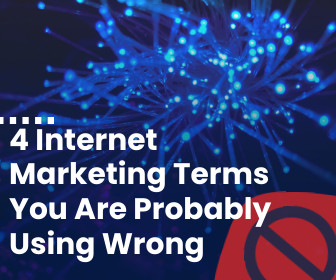
The internet and the marketing industry have something in common: They are full of terms and acronyms that can feel like an entirely different language. It can be super easy to misunderstand and/or misuse those terms. Here’s 4 “marketing/internet jargon” terms you are probably using wrong!
- Viral ≠ more views than you normally get
- Meme ≠ a picture with words on it. Please stop doing this
- Clickbait ≠ a catchy title
- Landing page ≠ a web page you’ve landed on
What do these words actually mean and how can you use them to communicate more effectively what you actually mean?
#1 Viral
What does it mean when you go viral? What makes something viral can be hard to quantify. There’s no magic number that means something is quote-on-quote viral. (Although MANY people try to make one.) Instead of defining viral by the numbers, it’s easier to quantify it by 2 things: reach and speed. The Wikipedia article on viral internet content makes the analogy that viral content is very similar to a virus. Viral internet content self-replicates and quickly spreads far from its original source. And often when content goes viral, it takes on its own life separate from what it was originally intended to be.
Let’s say one of your posts gets double or trip the amount of reach it normally gets. Is that viral? That’s very exciting, but no. Sorry! Although it’s possible to have something go viral with a specific community, viral implies exposure far outside it’s intended audience’s reach. With the number of platforms, and the cross-contaminating reach of those platforms, the general rule of thumb is over 2 million views in less than a few days to call something “viral.” This doesn’t mean that the content has to be a week old, it has to do with rate of expansion.
#2 Meme

This is one of my biggest pet peeves. It can be easy to look at a meme and think that any picture with words on it can be called a meme. It can be, but that doesn’t mean that it is. Meme was coined in 1976 by Richard Dawkins in his book on Darwinian evolution as an attempt to explain memetics; or, how ideas replicate, mutate, and evolve. What makes something a meme is not what it is, but instead the way that it replicates.
For example, the Star Wars “For the better, right?” meme has been a common format to use this month. What has made it a meme isn’t the original movie quote, or the format itself. It is a meme because many people are using or repurposing the format to convey information. Memes are only effective if the format conveys emotion or a message without it being explicitly stated and in a variety of different situations.

Although the types of memes we think of are usually in a concise image-based format, things like folk tales, urban legends, and chain letters are all versions’ memes. They are structured format in which information is shared and evolves.
#3 Clickbait
Are all catchy titles or hooks clickbait? No. The technical definition of clickbait is any text that is designed to entice a user to click or read on. However, the expression has a more specific connotation than that. It implies that the title isn’t accurate and is somehow disconnected from what you will see if you click. It’s similar to old school bait-and-switch marketing. Using bait or a hook isn’t wrong if you are looking to attract people, HOWEVER, the switch is wrong.
Clickbait is sensationalized content. An article titled “5 money making secrets you need to hear,” isn’t click bait if the article is actually about 5 money making tips. Which is part of what makes cracking down on malicious clickbait tricky. A lot of platforms like Facebook and YouTube measures in place to mark clickbait as spam. But how can AI decide if those 5 money making secrets are tips and tricks you actually need to hear? How does the platform know if those “secrets” can actually make you money? Clickbait is connected to consumer perception.
#4 Landing Page
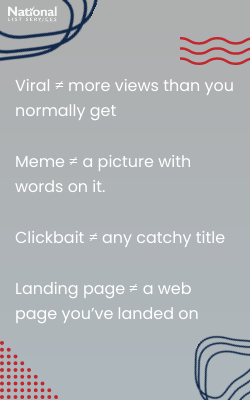
If you land on a webpage does that make it a landing page? No, because a landing page is a webpage you land on that is designed with a specific purpose in mind. One person illustrated it this way: You could use a baseball glove to retrieve a hot dish from the oven, but that doesn’t make your baseball glove an oven mitt. So just because someone lands somewhere doesn’t mean that it is a post-click landing page. The landing page could be designed get the user to make a purchase or fill out a form or watch a video. It doesn’t matter what the purpose is, it matters that it has one.
What is the advantage of separating your landing pages out to specify a single action? Research has shown that companies using 40 or more single action post-click landing pages generate 120% more leads than those using less than 5!
